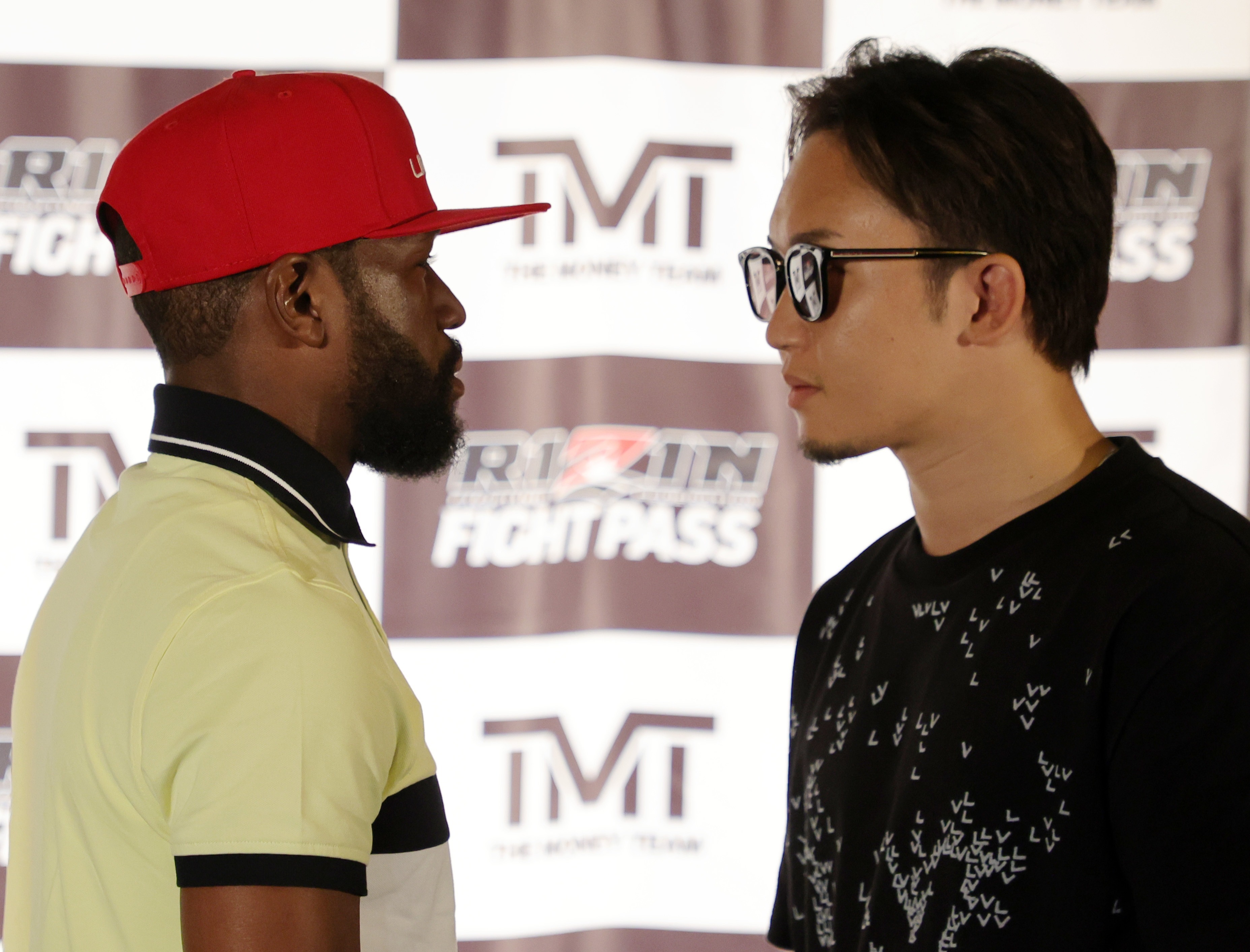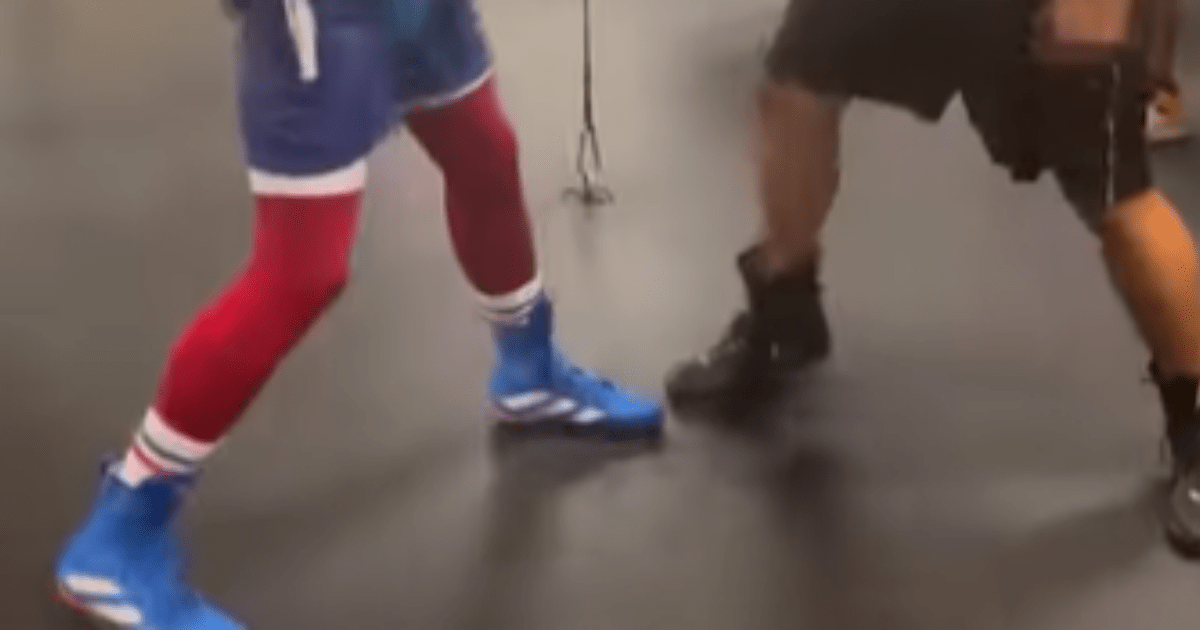FLOYD MAYWEATHER is in the gym training for a pair of upcoming boxing exhibitions.
The American legend returns to the ring in Japan on September 25 against MMA star Mikuru Asakura.
Floyd Mayweather is in the gym training for a pair of upcoming boxing exhibition
Floyd Mayweather training in his Las Vegas gym
And he is also in shock talks to face YouTuber Deji – the brother of KSI’s – on November 13 in Dubai.
Despite living the high life and retired from professional competition, Mayweather is at least keeping himself in shape for the money-grab cameos.
The Hall of Fame fighter was filmed by sparring partner Denis Douglin training in his Las Vegas gym.
Douglin, 34, posted on Instagram: I”‘m really watching Greatness and learning soo much.. He really doesn’t stop!”
Mayweather, 45, officially retired in August 2017 after beating ex-UFC champion Conor McGregor, 34, in ten Las Vegas rounds.
But he has boxed in three exhibitions since with his trip to Japan to face Asakura, 29, the latest.
It was in Tokyo in 2018 that Mayweather first returned, beating featherweight kickboxer Tenshin Nasukawa, 24, in one farcical round.
Then in June 2021 he went the eight-round distance with YouTuber Logan Paul, 27, giving away TWO STONE in doing so.
FREE BETS AND SIGN UP DEALS – BEST NEW CUSTOMER OFFERS
And most recently, Mayweather dominated former sparring partner Don Moore in Abu Dhabi.
It was the first fight under his Global Titans Fight Series with Deji expected to be the second opponent under his new banner.
Deji, 25, went on a run of three losses in the ring but secured his first win in August, beating online rival Fousey, 32.
 Floyd Mayweather and Mikuru Asakura ahead of their exhibition
Floyd Mayweather and Mikuru Asakura ahead of their exhibition
Frequently Asked Questions
How long does it usually take to become an elite boxer?
To become a professional boxer, it takes dedication and years of hard work. A minimum of 10 hours per week is required to train to become a professional ring fighter.
What are some ways I can improve my combat defense?
Learning how to fight intelligently can help you improve your defense. You must know how to defend against attacks from all angles, and you must also know how to counterattack if necessary.
You won’t be able to fight if you don’t know what fighting is. You’ll just get beaten up. If you know how to fight you will be ready for anything.
Here are some tips to help you improve your defense:
- Know the origin of your opponent’s attack. This means that you need to pay close attention and observe your opponent’s body language. This could be a sign that your opponent is preparing for his next attack.
- Remain calm. Don’t panic. Instead, try to remain focused and relaxed.
- Block with your arms. You can defend yourself against attacks by blocking with your arms.
- Counterattack. Counterattack.
- Fight dirty. Fight dirty. If you are being kicked by your opponent, you can respond by kick him back.
How long does it take for boxers to train each day?
Boxing trainers usually work out at least 4 hours a day. They also spend time studying boxing techniques, learning new moves, and practicing their punches. Boxers may spar up to ten times per week.
Do you have the ability to train yourself to box?
You can learn how to box. Find a local boxing gym and sign up for a class. You will find most gyms offering free classes. However, if there isn’t one near you, you can always search Google for local boxes clubs.
You will also need gloves, mouthpieces and headgear to sparring with your partners. Once you’ve got all of that, you can begin practicing your punches and kicks.
Do I have to fight in order to train boxing?
You can’t train boxing without fighting. It takes hard work to improve your boxing technique. It is possible to improve your boxing technique.
Watching good boxers fight is the first step to improving your boxing technique. Pay attention to how they move and throw punches. Also, observe how they defend themselves. You can then try to imitate them.
Next, you will need to spar against another fighter. Here you can see if you have improved your boxing technique. You’ll be amazed at how fast you can punch and how strong your punches feel.
Finally, you’ll need to practice your boxing skills by doing drills. Practice makes perfect, so be patient and persistent.
What is the best way to practice boxing punches in your home?
A punching bag can be used to practice boxing punches. The bag is used to practice boxing punches until you feel confident. Next, you’ll move on to the next part of your body. Once you feel at ease with one area you will move on.
Statistics
- This article received 39 testimonials and 89% of readers who voted found it helpful, earning it our reader-approved status. (wikihow.com)
- You want to be running at roughly 75-80% of your top speed..5 mile slow, easy recovery jog at the end.[6]X Research source 2Mix in long runs, shadow boxing, and short sprints on non-interval days. (wikihow.com)
External Links
en.wikipedia.org
expertboxing.com
How To
These are the basics of boxing
How to box efficiently
Boxing is one of the most popular sports in the world. It involves two people who attempt to knock each other out of their heads. The rules of boxing vary from country to country. There are three main types of boxing: Amateur boxing, Professional boxing, and Olympic boxing.
Amateur boxing usually takes place at school, college and university. This type of boxing allows sparring without protection. Amateur boxing competitions typically last for three rounds, each lasting five minutes. There are many different styles of amateur boxing including Kickboxing, Muay Thai, Taekwondo, Karate, Judo, Wrestling and others.
Boxing professionals are usually trained in clubs, gyms, or stadiums. They use protective equipment, such as mouthpieces, nose guards, shin protectors, elbow pads knee pads, waist belts and groin protectors. Professional boxing competitions include six rounds of four minutes each. There are many styles to professional boxing.
Olympic boxing takes place at the Olympics. International standards require that boxers use special protective gear. The competition lasts for eight rounds, each lasting three minutes. There are only two styles of Olympic boxing; Light Flyweight and Heavyweight.
These are the basic skills required to box.
- Punching techniques
- Guarding techniques
- Footwork
- Stance
- Movement of the body
- Defense
- Combination
- Rotation
- Spares
Punching Techniques
There are seven kinds of punches: Left Hook, Right Hook, Uppercut, Cross, Straight, Overhand and Underhand. Each punch is different. Some punches require more strength than others. For example, an uppercut is a powerful punch. However, a straight punch is much more powerful and faster than other punches.
There are also many combinations. These are combinations of punches that work together to achieve a specific goal. A combination may have multiple parts. A combination may include multiple parts. For example, damage to the jaw of an opponent can be caused by a left hook and a right cross.
Guard Techniques
To defend himself from being attacked, a boxer uses his entire body. He does this using his legs and arms, elbows as well as hands, knees and feet.
Legs
Boxers should use the legs to protect themselves against kicks. When he receives a kick, he raises his leg and moves away from the attacker. If the attacker is coming from the front, he will bend at the knees to avoid getting kicked on either side. He will block the kick with his foot if the attack is coming from behind.
Elbows
Because they inflict pain, elbow strikes can be very effective. You can either deliver an elbow strike directly, or indirectly. Directly means that you hit your opponent with your forearm while indirectly means that you hit him with another part of your arm.
Hands
Boxers use both their hands and arms to prevent incoming blows. To do this, they raise their fists higher than their heads and move their arms in the direction that the attack is coming. They then make contact with their attacker’s fist.
Knees
To absorb the impact of a punch to the stomach, abdomen, or chest, boxers should bend their knees. Defense purposes are often served by knee strikes.
Feet
Boxers should respond to being attacked by their opponent by standing back and delivering counter-attacks. This will allow him to gain distance from his opponent. Boxers should also keep their balance when counter-attacking.
Stances
A boxer must have a stance in order to be effective at boxing. The way he defends himself will be determined by his stance. It is how he positions himself and where he faces the opponent. Boxers have many stances to choose from. These are some of our most favorite:
- Low stance
- High stance
- Southpaw stance
- Western stance
Body Movement
To win a fight, a fighter must move around the opponent. This includes changing speed, position and rhythm.
Rotation
When a boxer throws a punch, he rotates in order to increase the reach of his arm. Depending on the type and size of punch, the speed at which the rotation takes place varies.
Combinations
Timing of each punch is crucial to the effectiveness of a combination. A good combination starts with a strong punch and ends with a weak one.
Spare parts
Sparring, a boxing practice session, is designed to improve your boxing skills. Sparring allows a boxer to improve his mental and physical skills. In conclusion, the purpose of sparring is to learn how to fight and not get hurt.
It is important to be patient and dedicated when learning how to box. Boxing is a sport that requires dedication and perseverance.

